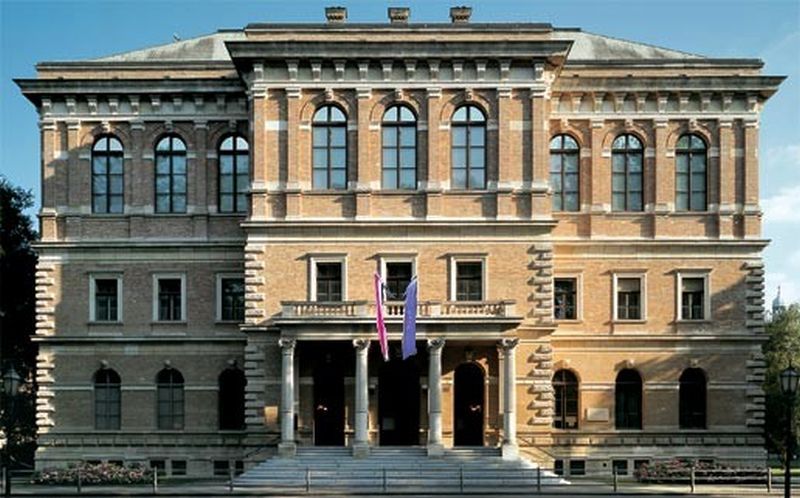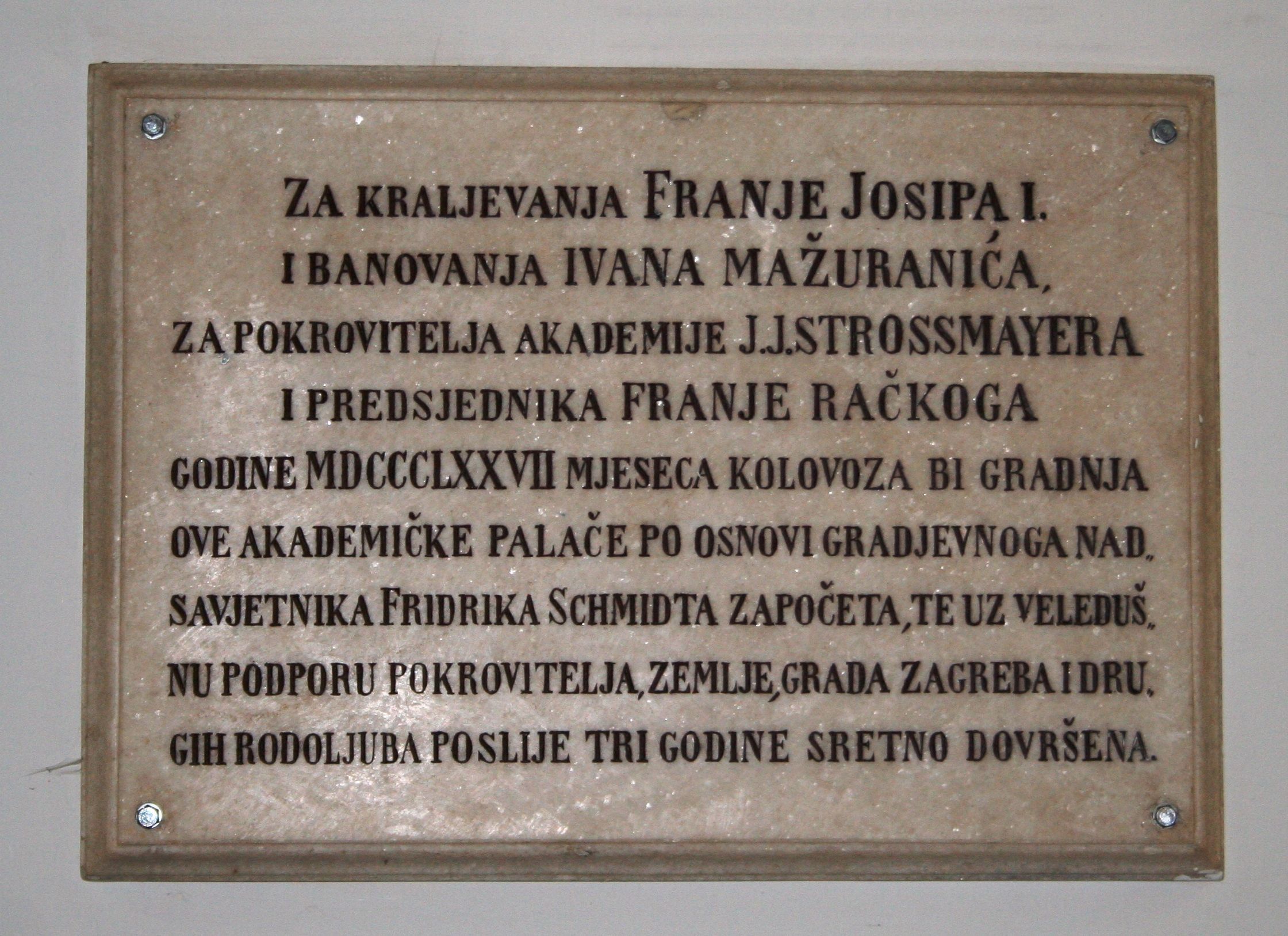In 1860, Josip Juraj Strossmayer, bishop of Đakovo and Srijem, took action to found a South Slavic Academy in Zagreb. He presented Josip Šokčević, the ban (Vice-Roy of Croatia), with a 50,000 florin endowment for the founding of the Academy. He also sent a letter expressing his wish that the Academy should “bring together the best minds (…) and find a way in which books in the national languages could be produced in the Slavic South; the Academy should also take under its aegis all the areas of human science”.

The facade of the Croatian Academy of Sciences and Arts palace Zagreb
The Academy issue was officially raised by Bishop Strossmayer at the Croatian Parliament session held on 29 April 1861. (today THE DAY OF THE CROATIAN ACADEMY OF SCIENCES AND ARTS) Following the bishop’s proposal, the Parliament immediately elected a committee to draw up a statute for the Academy, and define its aims and organization. It was only five years later, on 4 March 1866, that the rules of the Academy, in a considerably changed form, were finally confirmed by Francis Joseph I, Emperor of Austria and King of Hungary. These remained unchanged until the beginning of World War II. During the existence of the Independent State of Croatia (1941-1945), the name of the Academy was changed to the Croatian Academy of Sciences and Arts; in the Socialist Republic of Croatia it resumed its activities under the former name of the Yugoslav Academy of Sciences and Arts.

Memorial plaque to the construction of the Academic Palace on Zrinjevac
After the establishment of the independent and democratic Republic of Croatia, a bill concerning the Croatian Academy was proposed by the Academy. The new Croatian Academy Act was passed by the Croatian Parliament on 26 June 1991, confirming the importance of all the activities of the highest institution of sciences and arts in the Republic of Croatia.
Although the first act concerning the founding of the Academy in Zagreb was passed by the Croatian Parliament as soon as in 1861, its establishment was actually ratified only when its rules, which had been proposed by the Croatian Parliament in changed form as required by the Austrian authorities, were confirmed by the Emperor in his letter of 4 March 1866. After that, the Parliament proposed the first sixteen members of the Academy. In this way, the Academy was finally constituted, both actually and legally. Bishop Strossmayer was elected patron of the Academy, and Franjo Rački, a distinguished Croatian historian, its first president.
Under Strossmayer and Rački, the Academy became an eminent institution of learning, which collaborated with well-established European academies. Strossmayer called the Academy Yugoslav (meaning ‘Southern Slav’) because he wanted to promote the development of sciences and culture of all the South Slavic nations, including the Bulgarians. The Academy in Zagreb, however, has always been Croatian in its membership and its activities. Besides, soon after the foundation of the Zagreb Academy, the Serbian and Bulgarian Academies were established, so that the idea that the Academy in Zagreb was an institution which could bring together all the South Slavic nations became impracticable. All the publishing activities of Zagreb’s Academy have been primarily and permanently focused on the study of Croatian history, culture, language, and natural heritage.
Franjo Rački, the first president of the Academy, was an excellent organizer of scientific work. He initiated and edited a number of the Academy’s editions and publications. The first issue of the scholarly periodical Rad (Monographs) was published already in 1867. All of the Academy’s departments contributed to this periodical until its sixtieth issue in 1882. After that, several departments began to publish their own series of Rad. With 496 volumes published up to the present day, it is the largest series among the Academy’s publications.
Reception rooms in the palace of the Croatian Academy
The first volume of Ljetopis (Annals) was published in 1887, and it soon became one of the regular annual publications of the Academy, as well as its administrative messenger. One hundred and nine volumes of Ljetopis have been published so far. Since the study of Croatian history remained for a long time the main task of the Academy, the number of publications in this field increased considerably. As early as 1868, the Academy came out with the first volume of the Monumenta spectantia historiam Slavorum meridionalium, a series which publishes larger excerpts from archival documents (53 volumes have appeared to date). Starine (Antiquities), a series consisting mainly of fragmentary archival materials dealing with Croatian political and literary history, was first published in 1869. These main editions were divided into series, such as Monumenta Ragusina, Spomenici Hrvatske krajine (Documents of the Croatian Frontier-Zone), and Scriptores, selected works of early Croatian historians. Statutes of Dalmatian towns, feudal laws and early acts written in Croatian have been published in the series Monumenta historico-iuridica (13 volumes). Zbornik za narodni život i običaje Južnih Slavena (Collection on the Folk Life and Customs of the Southern Slavs) was first published in 1896, and 54 volumes have been published so far.
Among the most important of the Academy’s numerous publications are: Građa za povijest književnosti hrvatske (Documents for the History of the Croatian literature, 35 volumes); Diplomatički zbornik Kraljevine Hrvatske, Dalmacije i Slavonije (The Diplomatic Codex of the Kingdom of Croatia, Dalmatia and Slavonia, 19 volumes); Noviji pisci hrvatski (Modern Croatian Writers, 12 volumes); Hrvatski latinisti (Croatian Latinists, 11 volumes); Građa za gospodarsku povijest Hrvatske (Documents for the Economic History of Croatia, 21 volumes); Djela (Works, 80 volumes), series in which monographs on Croatia’s country, history and language are published; Prirodoslovna istraživanja (Natural History Studies, 107 volumes); Pomorsko pravo (Maritime Law, 10 volumes); Građa za pomorsku povijest Dubrovnika (Documents for the Naval History of Dubrovnik, 6 volumes); Problemi sjevernog Jadrana (The Northern Adriatic Issues, 8 volumes), etc.
The Croatian Academy of Sciences and Arts has organized over one hundred scientific meetings and conferences, evaluating works of important Croats throughout history. In addition, it has organized a number of symposia focusing on the history and economic development of Croatian regions, cities and towns, as well as on the problems of Croatia’s development. The Academy has published the following dictionaries: Mažuranić’s Prinosi za hrvatski pravno-povijesni rječnik (Contributions for a Croatian Historical Dictionary, 11 volumes), Benešić’s Rječnik hrvatskog književnog jezika od preporoda do l. G. Kovačića (Dictionary of the Croatian Literary Language from the National Revival to I. G. Kovačić, in 12 volumes), and Rječnik hrvatskoga kajkavskog književnog jezika (Dictionary of Croatian Literary Kajkavian, 10 volumes). The work on the large Rječnik hrvatskog ili srpskog jezika (Dictionary of the Croatian or Serbian Language, 97 volumes) went on for almost one hundred years.
Bishop Strossmayer initiated the construction of the Academy Palace on Zrinjevac, where he wanted to situate his gallery of paintings as well. The construction of the neo-Renaissance palace in Florentine style, as had been Strossmayer’s wish, began in August 1877, and it was completed in the summer of 1880. A quarter of the sum necessary to build the palace was donated by Strossmayer. Four years later, the Academy received the greatest of its patron’s donations: a collection of 256 works of art, mostly paintings (235) belonging to various Italian schools. The Strossmayer Gallery of Old Masters was opened in the Palace of the Academy on 9 November 1884 in the presence of Strossmayer himself.
Baška tablet, one of the oldest stone inscriptions in the Croatian language written in the Glagolitic alphabet,
transition XI. in XII. century, is kept in the Atrium of the Academy
Stay up to date with our events and receive more information about us and our activities.
Necessary cookies are absolutely essential for the website to function properly. These cookies ensure basic functionalities and security features of the website, anonymously.
| Cookie | Duration | Description |
|---|---|---|
| cookielawinfo-checbox-analytics | 11 months | This cookie is set by GDPR Cookie Consent plugin. The cookie is used to store the user consent for the cookies in the category "Analytics". |
| cookielawinfo-checbox-functional | 11 months | The cookie is set by GDPR cookie consent to record the user consent for the cookies in the category "Functional". |
| cookielawinfo-checbox-others | 11 months | This cookie is set by GDPR Cookie Consent plugin. The cookie is used to store the user consent for the cookies in the category "Other. |
| cookielawinfo-checkbox-necessary | 11 months | This cookie is set by GDPR Cookie Consent plugin. The cookies is used to store the user consent for the cookies in the category "Necessary". |
| cookielawinfo-checkbox-performance | 11 months | This cookie is set by GDPR Cookie Consent plugin. The cookie is used to store the user consent for the cookies in the category "Performance". |
| viewed_cookie_policy | 11 months | The cookie is set by the GDPR Cookie Consent plugin and is used to store whether or not user has consented to the use of cookies. It does not store any personal data. |
Functional cookies help to perform certain functionalities like sharing the content of the website on social media platforms, collect feedbacks, and other third-party features.
Performance cookies are used to understand and analyze the key performance indexes of the website which helps in delivering a better user experience for the visitors.
Analytical cookies are used to understand how visitors interact with the website. These cookies help provide information on metrics the number of visitors, bounce rate, traffic source, etc.
Advertisement cookies are used to provide visitors with relevant ads and marketing campaigns. These cookies track visitors across websites and collect information to provide customized ads.
Other uncategorized cookies are those that are being analyzed and have not been classified into a category as yet.